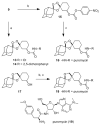Drug delivery to the malaria parasite using an arterolane-like scaffold
- PMID: 25314098
- PMCID: PMC4420023
- DOI: 10.1002/cmdc.201402362
Drug delivery to the malaria parasite using an arterolane-like scaffold
Abstract
Antimalarial agents artemisinin and arterolane act via initial reduction of a peroxide bond in a process likely mediated by ferrous iron sources in the parasite. Here, we report the synthesis and antiplasmodial activity of arterolane-like 1,2,4-trioxolanes specifically designed to release a tethered drug species within the malaria parasite. Compared with our earlier drug delivery scaffolds, these new arterolane-inspired systems are of significantly decreased molecular weight and possess superior metabolic stability. We describe an efficient, concise and scalable synthesis of the new systems, and demonstrate the use of the aminonucleoside antibiotic puromycin as a chemo/biomarker to validate successful drug release in live Plasmodium falciparum parasites. Together, the improved drug-like properties, more efficient synthesis, and proof of concept using puromycin, suggests these new molecules as improved vehicles for targeted drug delivery to the malaria parasite.
Keywords: Plasmodium falciparum; antimalarial agents; drug delivery; puromycin; targeted prodrugs; trioxolanes.
© 2015 WILEY-VCH Verlag GmbH & Co. KGaA, Weinheim.
Figures







Similar articles
-
Enantioselective Synthesis and in Vivo Evaluation of Regioisomeric Analogues of the Antimalarial Arterolane.J Med Chem. 2017 Jul 27;60(14):6400-6407. doi: 10.1021/acs.jmedchem.7b00699. Epub 2017 Jul 10. J Med Chem. 2017. PMID: 28692297 Free PMC article.
-
The structure-activity relationship of the antimalarial ozonide arterolane (OZ277).J Med Chem. 2010 Jan 14;53(1):481-91. doi: 10.1021/jm901473s. J Med Chem. 2010. PMID: 19924861
-
Probing the antimalarial mechanism of artemisinin and OZ277 (arterolane) with nonperoxidic isosteres and nitroxyl radicals.Antimicrob Agents Chemother. 2010 Mar;54(3):1042-6. doi: 10.1128/AAC.01305-09. Epub 2009 Dec 22. Antimicrob Agents Chemother. 2010. PMID: 20028825 Free PMC article.
-
Exploration of artemisinin derivatives and synthetic peroxides in antimalarial drug discovery research.Eur J Med Chem. 2021 Mar 5;213:113193. doi: 10.1016/j.ejmech.2021.113193. Epub 2021 Jan 18. Eur J Med Chem. 2021. PMID: 33508479 Review.
-
Spiroindolone NITD609 is a novel antimalarial drug that targets the P-type ATPase PfATP4.Future Med Chem. 2016;8(2):227-38. doi: 10.4155/fmc.15.177. Epub 2016 Jan 29. Future Med Chem. 2016. PMID: 26824174 Review.
Cited by
-
Lewis Acids and Heteropoly Acids in the Synthesis of Organic Peroxides.Pharmaceuticals (Basel). 2022 Apr 13;15(4):472. doi: 10.3390/ph15040472. Pharmaceuticals (Basel). 2022. PMID: 35455469 Free PMC article. Review.
-
A reactivity-based probe of the intracellular labile ferrous iron pool.Nat Chem Biol. 2016 Sep;12(9):680-5. doi: 10.1038/nchembio.2116. Epub 2016 Jul 4. Nat Chem Biol. 2016. PMID: 27376690 Free PMC article.
-
Elevated labile iron in castration-resistant prostate cancer is targetable with ferrous iron-activatable antiandrogen therapy.Eur J Med Chem. 2023 Mar 5;249:115110. doi: 10.1016/j.ejmech.2023.115110. Epub 2023 Jan 14. Eur J Med Chem. 2023. PMID: 36708680 Free PMC article.
-
Expanded scope of Griesbaum co-ozonolysis for the preparation of structurally diverse sensors of ferrous iron.RSC Adv. 2021 Oct 22;11(54):34338-34342. doi: 10.1039/d1ra05932g. eCollection 2021 Oct 18. RSC Adv. 2021. PMID: 35497286 Free PMC article.
-
Efficient and stereocontrolled synthesis of 1,2,4-trioxolanes useful for ferrous iron-dependent drug delivery.Org Lett. 2014 Nov 7;16(21):5776-9. doi: 10.1021/ol5028392. Epub 2014 Oct 21. Org Lett. 2014. PMID: 25331549 Free PMC article.
References
-
- Vennerstrom JL, Arbe-Barnes S, Brun R, Charman SA, Chiu FCK, Chollet J, Dong Y, Dorn A, Hunziker D, Matile H, et al. Nature. 2004;430:900–904. - PubMed
-
- Dong Y, Wittlin S, Sriraghavan K, Chollet J, Charman SA, Charman WN, Scheurer C, Urwyler H, Santo Tomas J, Snyder C, et al. J Med Chem. 2010;53:481–91. - PubMed
-
- Marti F, Chadwick J, Amewu RK, Burrell-Saward H, Srivastava A, Ward Sa, Sharma R, Berry N, O’Neill PM. Medchemcomm. 2011;2:661.
-
- O’Neill PM, Posner GH. J Med Chem. 2004;47:2945–2964. - PubMed
Publication types
MeSH terms
Substances
Grants and funding
LinkOut - more resources
Full Text Sources
Other Literature Sources

